

This paper shows how insecure, inflexible and excessive hours in frontline sectors exacerbate the UK’s economic inactivity problem – and what to do about it.
By Clare McNeil, Timewise CEO, and Tess Lanning, Director of Programmes
The Government has set out a welcome ambition to support full employment in the UK – with a big focus on tackling the large rise in the number of people who are ‘economically inactive’ due to ill-health.
Increasing the number of jobs that offer people the flexibility to manage their health conditions is critical to this agenda: surveys show that the majority of health and disability benefit claimants want to work in part-time, flexible roles, with the option of working from home.
In practice, however, this Timewise report demonstrates the huge mismatch between the work people say they want to do and the work they are most likely to do – with job quality issues in frontline sectors creating a revolving door of economic inactivity.
Our analysis shows the realities of where people with health conditions end up working, and why many struggle to stay in employment. The sectors with the highest long-term sickness rates are retail, transport, hospitality, health and care, followed by construction, manufacturing and education.
Original Timewise analysis shows that:
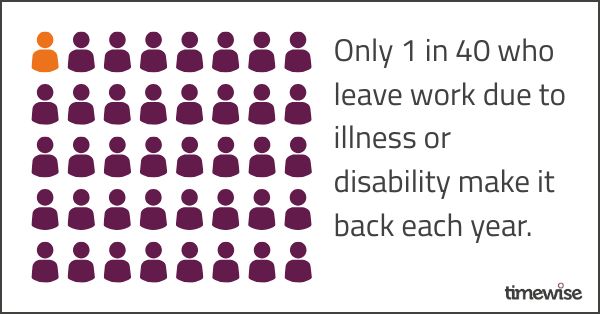
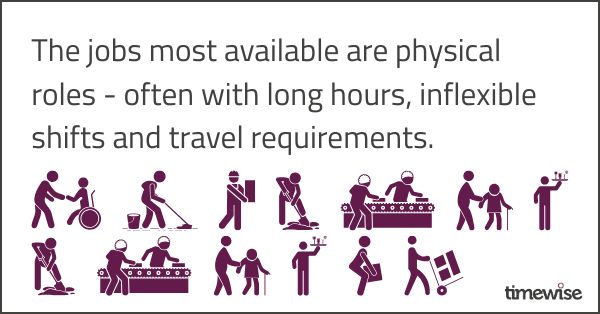
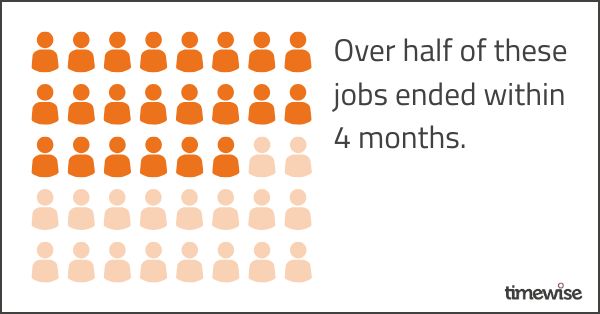
Without action to increase schedule flexibility and control for workers in these sectors, the government’s return on investment in back-to-work support for the formerly inactive long-term sick will be disappointing.
We call for a new industrial strategy for good jobs, focused on improving job quality and performance in the ‘everyday’ economy where most people work, starting with three central reforms:
Successive government administrations have neglected issues of job quality in frontline sectors. New rights due to come into force will tackle some of the worst practices associated with zero- and low-hours contracts, including short term notice and cancellations to shifts. A broader industrial strategy for good jobs would signal a more ambitious approach that ensures jobs support employee health and wellbeing. In doing so, it wouldn’t just help people back into work, it would ensure they can stay in work and thrive.
Published September 2025

By Clare McNeil, Timewise CEO
The departure of Angela Rayner and machinery of government changes we have seen in the last few days have exposed some of the tensions that surround the government’s approach to one of its most high-profile pieces of legislation, the Employment Rights Bill. It has also raised questions about whether we are likely to see ‘continuity or change’ in regard to this.
Even before the government reshuffle, the government was facing questions about its intent on the Employment Rights Bill, given the long timescales for implementation of key measures and a lack of resources focused on implementation and enforcement.
But with a new ‘super-ministry’ at the Department for Work and Pensions (DWP) which is expected to incorporate adult skills under the new Secretary of State Pat McFadden, the drawbacks of this approach may become more apparent. The very groups DWP (and HM Treasury) urgently need to get back into the workplace – those who are economically inactive due to disabilities and long-term sickness and their parents and carers – are mostly likely to do so with exactly the flexible, secure and predictable work the Employment Rights Bill encourages employers to offer. For example, as many as two-thirds of disabled people who are currently not working and receiving incapacity or disability benefits need to work flexibly or part-time to get back into work, as the Resolution Foundation recently found.
One of the arguments against the proposed legislation on flexible working and zero-hours contracts is that it is unworkable. But look at what businesses are doing rather than what lobby groups are arguing on their behalf: increasingly employers are offering minimum guaranteed hours, giving workers more say and control over their shift patterns and fair notice of both schedules and changes to stay competitive in a challenging recruitment market. We published many examples from leading employers in Timewise’s Ending the Two-Tier Workforce report earlier this year.
The expected transfer of adult skills into the DWP portfolio raises hopes of closer working with the Department for Business and Trade (DBT) on a whole set of issues – from the role of employers in young people’s employment, to improving poor employer utilisation of skills which leaves so many talented (often part-time) workers behind and businesses missing out on talent. Even before these changes in government, a busy autumn was shaping up on the work and health front. Three key events Timewise will be focused on:
The Employment Rights Bill will be the subject of ‘ping pong’ between House of Lords and parliament over the next few weeks. House of Lords amendments have paved the way for key proposals on offering guaranteed hours to an employee and paying for cancelled shift work to be removed or watered down.
One of the arguments against these proposals is that they are unworkable. But Timewise has worked with many employers who are voluntarily adopting these ways of working to recruit and retain the best staff. See positive examples from employers such as WH Smith (TG Jones) and Timewise advice for employers here:
We can’t simply legislate our way to better work. In spite of the many pressures facing business, Sir Charlie Mayfield is likely to argue in his Keep Britain Working review that it is in business interests to work with government to tackle rising working age ill health. In our response to the consultation Timewise argues a key test for the Review will be whether it can make a difference for the ‘deskless’ workers in frontline sectors where rates of inactivity are highest – like retail, transport, health & care and construction. That means a voluntary framework alone is unlikely to be enough.
We’d like to see agreements for employers, workers and experts to come together to drive up standards, reduce sickness absence and improve retention rates. The White Paper expected from DWP this Autumn is another vital chance to influence employer behaviour to create the part-time and flexible work those with health conditions and disabilities vitally need.
With more public sector strikes potentially on the horizon for this Autumn, we must recognise that pay is just one factor. Surveys of frontline workers show that self-respect, dignity, autonomy and flexibility at work matter as much as levels of pay. Denied requests for flexible working, heavy workloads and the introduction of new technologies are taking their toll on public sector workers.
Expected workforce plans in health, education, childcare and the fair pay agreement for social care are a chance to turn this around. Critical to this is what the TUC are calling a pro-worker strategy on AI: the use of gig work apps and workforce scheduling tools, for example, can make work more insecure, increasing worker surveillance and undermining regulation. Improving insights into the best and the worst of these technologies is vital and a key focus for Timewise in the months ahead.
Published September 2025
By Tess Lanning, Director of Programmes
The next 12-18 months present a critical opportunity to improve employment outcomes for young people, as the government introduces a range of initiatives to tackle a rise in worklessness and insecurity.
As well as an increase in the age young people will be able to claim health-related benefits, this includes initiatives to improve the quality of jobs available. A new Youth Guarantee commits to providing decent training, apprenticeship and job opportunities for 18 to 21 year olds, while the Employment Rights Bill seeks to tackle high levels of low pay and insecurity in the economy.
Job insecurity disproportionately affects young people. Government statistics show that one in eight young workers are on a zero-hour contract, compared to less than one in 40 older workers, and young people are more likely to work volatile and variable work schedule patterns. Research has shown this is not only bad for early career job prospects – but can have a lifelong negative impact on employment, earnings and health outcomes (see Paul Gregg’s 2024 thought paper on future policy and Wen-Gui Han’s research article in to the effects of employment patterns on health in the US).
Government action to tackle these issues is therefore to be welcomed. But will employers engage with these initiatives? And if so, will young people see the benefits?
In June 2025, Timewise and Youth Futures Foundation gathered with employers from diverse sectors to find out.
Employers highlighted the focus on securing employees that can ‘hit the ground running’ in the context of rising financial pressures, combined with a reliance on tried-and-tested recruitment, selection and induction methods that favour older and more experienced workers.
Critically, they felt that there was a mismatch between dominant workplace cultures and the values, needs and expectations of younger workers – particularly in frontline sectors, where employers were finding it difficult to provide greater stability, security and flexibility at work. Many were struggling with skills gaps and vacancies as a result.
Employers had ideas for how to tackle these issues – from changes to hiring practices, management training, and more visible information about pay, progression and flexible working policies, to the creation of employee forums to co-design and support changes that improve long-term employment and health prospects for young people.
But they also highlighted the need for more support and evidence to inform good practice – particularly on issues affecting job security, such as scheduling practices and shift patterns. Without this, the new legislation may fail to hit the mark for young people.
Get in touch to understand how you can implement or inform good practice in these areas: info@timewise.co.uk
Published July 2025
Access to part-time and flexible working is highly valued and far more easily available to those in office based and higher earning jobs. Site-based and shift-based workers, such as medical staff, transport workers, nurses, cleaners, retail assistants and construction workers, who all make up our everyday economy, typically have little or no flexibility in their roles, resulting in a ‘two-tier workforce’.
In partnership with abrdn Financial Fairness Trust, we set out to understand the potential for improving access to quality flexible work in four sectors that have a high proportion of shift and site-based work. Our research focused on frontline employees’ autonomy and control over the hours they work, and when and where they work, in health and care, retail, construction, and transport and logistics. We chose to focus on these sectors for the following reasons:
These four industries make up more than a third of UK employee jobs, so provided a representative test of whether and how the new legislation will improve work-life balance for site-based and shift-based workers.
We engaged with employers, workers, experts and sector representatives over 12 months, starting with in-depth industry research. This included a review of literature and interviews with HR and senior operational leads across the four sectors.
This was to understand:
Then we further tested and refined our findings with sector stakeholders to develop practical strategies to increase the adoption of flexible and secure work in their industries, taking into account the impact for employers, sector bodies and government.
We did this through a number of roundtable discussions with employers, trade unions and sector bodies, chaired by sector leaders including Danny Mortimer, Chief Executive of NHS Employers; Helen Dickinson OBE, Chief Executive of the British Retail Consortium; Kim Sides, Executive Director of BAM Construction; and Kevin Green, Chief People Officer at First Bus and Timewise Chair, as well as focus groups with lower-income workers in site-based roles.
It was clear that a different set of principles and ways of talking about how work is designed is needed to encourage frontline employers to be able to change the way that rosters and shift patterns are created. Our ‘Shift-Life Balance Model’ recognises that it’s key to understand the size and volume of work first of all, then consider employees’ input into their schedule, fair notice of shift patterns as well as regular work patterns.
A common vision for secure and flexible work in frontline sectors
Our engagement with employers, sector bodies and workers revealed that, with the right sectoral strategies, incentives and support, is it possible to implement flexible and secure work in frontline sectors of the economy. Insights from the industry panels suggested three building blocks for making progress on this good practice vision:
Whilst there are a few examples of excellent practice, there is still a long way to go to establish secure and flexible working cultures more broadly. Workers are concerned about flexibility that favours employers, but doesn’t give them any input, control or security themselves.
![Worker voices: Quote 1, They think that they give you flexibility then the company will get out of control. A domino effect. Quote 2, I wouldn't be brave enough to ask [for flexible working] for fear it might damage my career.](https://timewise.co.uk/wp-content/uploads/2025/01/Industry-Leaders-Infographic-worker-voices.jpg)
Our research revealed some complex barriers to realising flexible and predictable working models, including:
The core challenge is to drive the good practice by a small number of individual organisations towards a more cross-sector approach, mainstreaming predictable and flexible working cultures across industries.
Our research has shown that a stronger statutory framework alone will not produce the workplace culture, business and operational shifts needed to tackle ‘one-sided flexibility’ in favour of employers, particularly for those in shift or site-based roles in frontline sectors. We have identified two key weaknesses (detailed in the report) and believe that a sector-based approach is essential for real change to take place.
We have established a coalition of leading employers, sector bodies and union representatives who are calling for government to work in partnership with industry and workers to ensure legislative proposals in the Employment Rights Bill can be successfully implemented.
This is urgently needed to give workers in the ‘everyday economy’ greater control and predictability and to realise the government’s wider goals on workforce participation, reducing economic inactivity and achieving inclusive economic growth.
Four ‘sector guides’ are published alongside this report offering sector-specific recommendations for employers and sector bodies on improving access to flexible and predictable work for frontline employees.
Published January 2025
Despite being a critically important sector for the UK’s economy and society, childcare providers are struggling to recruit and retain staff. Delivering good quality early childhood education and care is key to enabling parents to work and contribute to economic growth, yet staff are facing longer hours and lower pay than comparable occupations for what can be more emotionally and physically demanding work.
This is not sustainable and action must be taken to improve staff satisfaction and to make those working in early years education feel more valued and supported. The pressure on the sector will only increase further as the government rolls out the funded childcare entitlement expansion over the next year, forecasting that an additional 35,000 new places for zero to two-year olds will be needed by September 2025.
The Timewise Childcare Pioneers project explored how proactive flexible working cultures could improve staff wellbeing and engagement and attract a more diverse pool of candidates – such as older workers and those with caring and health responsibilities.
We worked with the Early Years Alliance, representing 14,00 members, and the London Early Years Foundation, representing 40 nurseries, to explore the role improved flexible working could play in tackling the current workforce crisis facing the sector, and to understand what improvements are possible without compromising the quality of education and care that meets the needs of parent and children.
Then we designed and delivered a set of activities and tools to support nurseries to be more consistent in their approach to flexible working, and to help them to consider and trial new approaches to increase the availability of quality flexible work.
Our thanks to JPMorganChase and Trust for London for supporting this project.
Our initial diagnostic work found that part-time and flexible working is relatively common in childcare provider settings, and steps had been taken by both nursery providers to improve the information and support available to nursery managers to help them respond to flexible working requests fairly and consistently. However, staff felt that these arrangements were sometimes rationed, and their requests were not always seen as significant. They also felt that many managers set shift patterns without their input, and organisational needs were considered above staff needs, leaving them feeling less valued and less able to balance work and life commitments.
Head office staff and nursery managers highlighted that flexible working could make it harder to meet statutory staff-child ratios, recommended training standards, parents’ needs for flexible care, and provide continuity of care for the children. Managers are under pressure to juggle all these factors when setting schedules and are concerned that having more part-time staff and enabling flexible working patterns for some individuals would negatively impact others’ workloads.
“It’s really difficult because everything that we do is planned around ratios. And if you’ve already got a certain number of children and you’ve hit your maximum number of children with the staff that you’ve got, being flexible isn’t always possible.”
Nursery manager
“Flexible work works better in some types of settings than others. It depends very much on types of funding and types of hours parents need… More affluent areas means less availability of the 15 hour entitlement for two-year-olds, with an increasing focus on parents working three long days a week and wanting Monday and Friday off. Staff say Tuesday to Thursday are very mixed days and then Friday is half empty and Monday mixed. This has particular implications [for nurseries] as often the parents who want this have babies, and baby care needs high ratios and consistent care. Nannies and grandparents are also in the mix in different proportions in different settings.”
Director, nursery group
We found that leaders, managers and staff in nursery settings were keen to make improvements to their flexible working offering to help retain and attract staff, provided operational challenges could be overcome. With limited capacity to pilot new approaches due to high workloads and staff shortages, our project focused on improving the confidence, skills and knowledge gaps of nursery managers with a set of resources and tools.
The project showed that it is possible to improve flexible working in the childcare sector, and that this can be one part of a solution to current workforce challenges. However, it also highlighted the need for practical support to help employers implement changes in a sector where funding constraints and acute staff shortages are limiting the capacity for innovation.
If flexible working is to be adopted more widely across the sector, it is clear that concerted action is needed at both local and national level.
How to attract and retain talent through enhanced flexibility for the workforce
Published November 2024

By Dr Sarah Dauncey, Head of Partnerships and Insight, Timewise
Occupational segregation is a distinctive feature of the UK’s labour market and a driver of persistent inequality, in income and more widely in health. Workers from black and minoritised ethnic groups are overly represented in sectors where site-based, insecure and lower-paid work is prevalent. People from minoritised groups are also more likely to have a higher risk of developing long-term health conditions, which can affect people’s ability to work – especially in site-based and more physical roles. The pandemic exposed the health inequity arising from this, with minoritised ethnic groups disproportionately impacted because of the increased likelihood of being a frontline worker without the option to work from home.
These patterns are too often replicated within organisations, with people from minoritised ethnic groups overrepresented in lower-paid, site-based roles and functions like security, cleaning, catering and caretaking which typically have more limited access to flexible options. Where an organisational focus is on hybrid as a flexible option, disparities are intensified. Further, within their workplaces, workers from minoritised ethnicities can experience a sense of precarity or inferiority that restricts their confidence to challenge decision-makers and request reforms to conditions or working patterns for fear of losing their job.
This means that workers from black and minoritised communities are overall less likely to make the most of the workplace benefits that support better health. This includes the improved work-life balance that comes from better autonomy and flexibility. Unhealthy working conditions contribute to ill-health, and ill-health restricts people’s ability to work, creating a cycle that is increasingly difficult to overcome in the context of the rising cost of living.
It’s in the context of this structural inequality that Runnymede and Timewise established a partnership, with the support of Impact on Urban Health. We wanted to better understand the relationship between flexible working and organisational approaches to equality, diversity and inclusion, and how site-based workers from black and minoritised ethnic backgrounds perceive and experience flexible working.
More specifically, we wanted to find out how new ways of working supported or thwarted a sense of inclusion and belonging. This involved us speaking with two stakeholder groups in participating organisations, leaders of site-site based teams and their employees. We took an action-oriented approach to our research, ensuring that our insights drove meaningful change in participating organisations to address processes of exclusion.
The recent racist rioting, driven by a combination of routine, normalised discrimination – heated-up over recent years by mainstream politicians and media – has raised the stakes of our research and its implications for both workers and organisations. Our interviews were undertaken early in 2024. We heard workers’ sense of fear, their reluctance to ‘rock the boat’ and ask for working patterns that might challenge ‘ideal worker’ (i.e. white and male) stereotypes. People who have experienced, or are experiencing, racial trauma invariably have a different set of expectations about their level of input and control over their working pattern.
During the riots, we read harrowing accounts in the mainstream media of people facing physical and verbal threats because of their skin colour or religion, instilling fear among people from black and ethnic minorities across the country. While we welcomed hearing about employers who led with empathy and offered increased protections to their employees, including the opportunity to work from home if they were able to, we were mindful of the risks that site-based workers had to face. Yet again, people from black and ethnic backgrounds who worked in jobs with fixed locations faced greater exposure, this time, not to disease but to an outbreak of violent racism.
This disparity once again highlights the urgent need for employers of site-based staff to think both strategically and creatively about flexible options and how they can be used to value employees and provide work-life support. Our research shows how critically important it is for employers to be pro-active here, talking openly – to all – about available flexible options. Signposting them rather than expecting employees to have the confidence to ask for them.
Our study uncovered a complex of factors that posed barriers to site-based employees accessing flexible options. These broadly fall into three categories: operational, managerial and cultural. We found that employees’ race and ethnicity shaped their workplace interactions and expectations around working patterns and level of empowerment to pursue change. Here’s a summary of some of the main barriers that we identified.
These barriers, contributing to a diminished sense of autonomy, gave rise to frustration and personal stress among some employees – impacting on their sense of wellbeing and work-life balance. Moreover, participants recognised the connections between input and control over ways of working and organisational benefits, not just personal ones. They spoke of the gains that would flow from feeling trusted and more autonomous and empowered, such as higher levels of commitment and productivity.
Leaders participating in the research recognised the potential of flexible working to support inclusion priorities but were alert to the realities on the ground and the effect of variations in managers’ attitudes and approaches. They were aware of a disconnect between policy and practice leading to disparities. Organisational values and commitments weren’t being evenly role modelled and applied by managers.
So, what are the solutions to help employers navigate these challenges, improve their working cultures and deliver on equity and inclusion?
While localised initiatives need to be tailored and based on insights and measurement, we’re pleased to share some general insights from our research to drive meaningful organisation-wide action to address workplace inequalities and call out processes of exclusion.
We’re aware that further research is needed to deepen understanding of the complexity of the challenges facing minoritised ethnic workers over accessing flexible working options. The employers who partnered with us showed bravery and commitment to tackling systemic, structural and cultural challenges. They have sustained work ahead to deliver change, but a clear sense of where they’re heading and a route to get there with accountability in place. We’re delighted to say our peer researchers have now become pivotal to holding their organisations to account on delivery equity in access to flexible options, and ultimately better health.
Published November 2024
The pandemic amplified existing labour market inequalities in access to flexible working and we’re still reeling from the effects of this, especially in the context of health. While half of working adults were able to work from home at times during the pandemic, others weren’t given this option due to the location-based nature of their work.
The reality of a two-tier workforce – the ‘flexible haves and have nots’ – became starkly apparent along with the implications for worker health and wellbeing.
Emerging from the pandemic, workers given home-based options have expressed a strong interest in maintaining them. Many employers have responded to this demand by developing hybrid policies and practice, recognising its value for attraction and retention. Yet there’s been limited coordinated action to redress workplace inequalities by investing in innovation and design to organise work differently for frontline and site-based employees.
So, supported by Impact on Urban Health, Timewise joined with the Institute for Employment Studies (IES) and three trailblazing employers – Guy’s and St Thomas’ NHS Foundation Trust, Sir Robert McAlpine and Wickes – in a two-year long action research programme to introduce flexibility into frontline roles and evaluate its impact, on both the individual and the organisation. Our report outlines the findings from our journey together and shares learnings to make access to flexible working more equitable.
We tested the idea that good quality flexible work improves employee health and wellbeing, leading to benefits for employers, such as improved retention. Timewise co-designed activity with each of the three participating employers to give site-based workers greater input and control over their working patterns. Then in collaboration with IES, we considered the impact of increased flexibility on individuals from the point of view of their experience of health and wellbeing, work-life balance and job satisfaction, and on organisations from the perspective of levels of engagement, attendance and retention.
Our programme shows that flexibility is both central to how people want to work in the future and is practically possible even in ‘hard to flex’ roles. Where flexibility is introduced with the support of senior leaders, and is driven by teams at a local level, it results in positive impacts for both individuals and organisations. Workers report improvements to health and wellbeing, work-life balance, and a desire to stay longer with their employer. For employers, this means higher levels of employee engagement, lower levels of sickness absence and increased staff retention.
For the organisations involved in this programme, there’s no going back to former ways of working. They’ve embraced the changes and are moving forward with plans to scale up to ensure all are able to benefit through increased input and control over their working pattern.
Published July 2024
By Emma Stewart, Co-Founder
It’s almost a year since Timewise reported on ways to increase flexible working in the film and TV industry. Our conclusion back then was that the biggest challenge for people who work in this sector is not so much a lack of flexibility, as simply its long hours’ culture.
With 10+ hours hard-wired into daily film schedules, the problem is structural. And with management fears of additional costs to change the approach, coupled with the absence of any detailed analysis of how to make this work, the working model is in a stalemate situation.
So this latest project has assessed the viability of a shorter working day of 8 hours. We looked at working models in other countries, polled over 800 UK crew members, and shadowed two productions to explore the likely impact of a shorter day on the filming process and its budget.
The result is a blueprint for an 8 hour filming day, with guidelines on how to implement it successfully and projections for the likely additional costs (which turned out to be considerably lower than feared).
The next step? We now hope that our findings will encourage the commissioning of a future drama production on a shorter day model, and are talking with a number of commissioners and funders to take this forward. If successful, the idea is to share the results of the pilot across the industry to drive top down change for the benefit of all who work in this creative but stressful sector.
Published February 2024
The aim of A Question of Time is to capture the whole picture of part-time working in the UK, right now. It’s not a simple story.
In partnership with Opinium, we surveyed both full-time and part-time 4,001 workers and undertook focus groups to gain a deeper understanding of people’s experiences of and views on part-time working.
There’s a mixed story of blocked career paths, conflicting views – and a glimpse of hope (see our video).
Reduced hours are seen as a central way to manage life and health needs. But there are distinct cultural and economic barriers to overcome. Part-time work is perceived to limit career progression, particularly among the ‘gatekeepers’ of career success: managers.
Yet, ironically, managers are the most likely occupational group to express an interest in working part-time in the future.
In this report, we shine a spotlight onto people’s experiences and perceptions of part-time working to contribute much needed new insight into labour market inequalities. By gathering a deeper understanding of the realities of part-time work, and differing attitudes towards it, we’re better able to direct action to deliver change, improving the lives of workers by granting them greater flexibility and choice.
Part-time employment is prevalent in the UK, especially among women. However, there has been a slow decrease in women’s participation in part-time work, and a slight increase in men’s.
41% of people work part-time to manage either care or home related responsibilities, and 22% work part-time to better manage their mental and/or physical health. The findings highlight the gender inequalities associated with caring responsibilities, yet also draw attention to the health crisis.
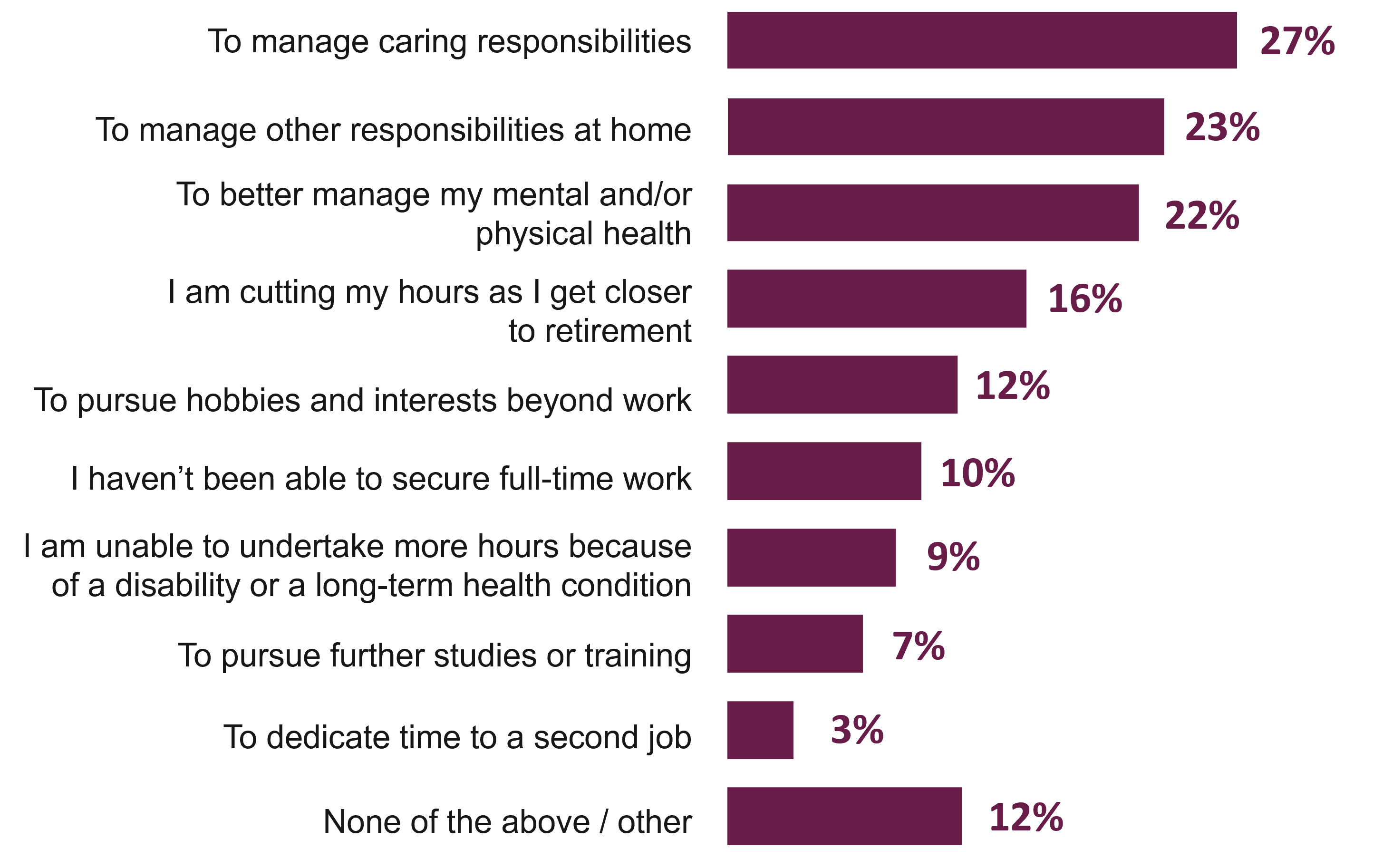
Covid has changed things. People want to pursue interests beyond work. Part-time shouldn’t just be for parents.
YOUNGER WORKER, FOCUS GROUP PARTICIPANT
Nearly half of all survey respondents believe part-time working can limit career progression, and over a third of workers consider it to be primarily for parents and carers, rising to 1 in 4 among those in the managerial occupational group.
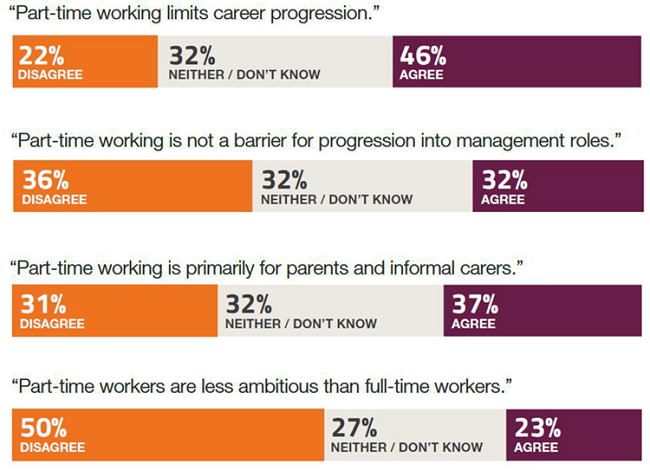
Differences in the perception of the status of part-time work by age, ethnicity, education and occupation include:
While half of the survey respondents would be happy to talk to their employer about changing their working arrangements, 30% would not be comfortable discussing reduced hours. Of the respondents, younger workers and those with temporary contracts were least comfortable discussing changing their working arrangements. However, this group were more likely to consider taking advantage of the new day one right to request flexible working in a future role, and significantly more respondents from black minority ethnic groups than white ethnic groups would do the same.
The focus groups supported these findings as well as highlighting that workers were more comfortable discussing working arrangements once more established in their role, with a build up of trust between employer and employee.
At junior level, it’s difficult to discuss flex but as you become more senior and gain trust and respect, it’s easier to pursue it. The ‘right to flex’ is seen as a reward for good work and being trusted. It’s something you earn and isn’t something you automatically have.
OLDER WORKER, FOCUS GROUP PARTICIPANT
Our new findings show there’s a strong demand for part-time working, regardless of gender, occupation and income, and it has a key part to play in tackling societal challenges such as managing health and wellbeing and the increased burden of social care. There is an urgent need for joined up action by employers, policymakers and government to tackle inequalities in the part-time labour market and create more inclusive workplaces where employees can thrive.
So what can employers do today to make a difference?
Timewise is grateful to our corporate supporters for making the project possible: Diageo, Lloyds Banking Group and Phoenix Group.
Published December 2023
Watch the Timewise A Question of Time webinar below:
Our 9th annual Flexible Jobs Index© reports negligible change on the previous year’s level of job adverts offering flexible working. Only 31% do so, signifying an end to the progress that was made during and since the pandemic, when hybrid working became the norm for many UK jobs.
The stagnation is surprising in the light of the Employment Relations (Flexible Working) Act 2023, with its accompanying regulation giving people the right to request flexible working from day one in a new job. It suggests that many employers remain resistant to flexibility for new recruits, and are not preparing for the change that is coming when the new law is implemented next year.
To be fair to employers, complex workplace transformation takes time. And the pressure to adapt to flex coincides with huge challenges in terms of pay rises to cover the increased cost of living, whilst grappling with an economic downturn. However, it has never been more important to look beyond the barriers and consider the evidence that flexible working is a powerful talent attraction tool. Candidates increasingly want and expect to be able to work flexibly, and with new legislation on the way that is not about to change.
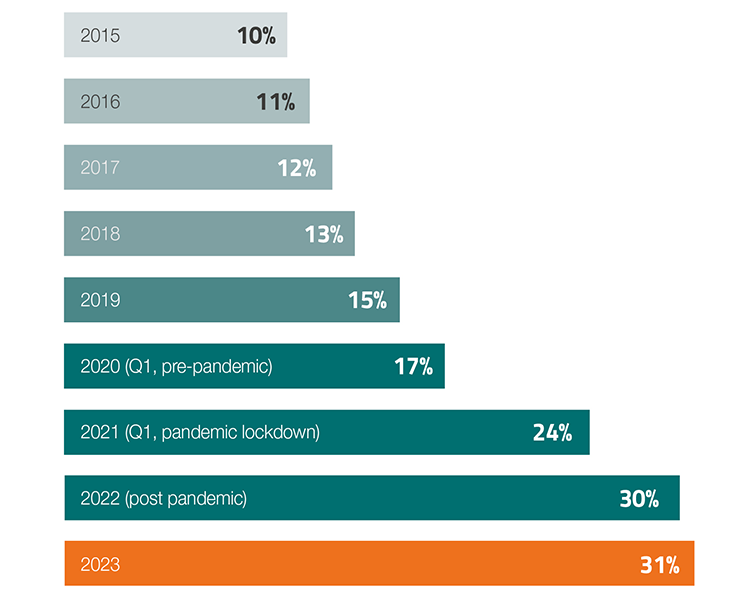
The proportion of job adverts which offer flexible working appears to be stalling. The 2023 rate of 31% represents barely any increase on 30% in 2022, and follows three years of a marked upward trend during and since the pandemic, as many organisations embraced hybrid-working.

The supply of flexible vacancies lags far behind demand. 6 in 10 employees can access the benefits of flexibility in their current job, and many more people want to work flexibly. Yet only 3 in 10 jobs are advertised with flexible working – or, to look at it another way, people who need flexibility are unable to apply for 7 in 10 jobs.
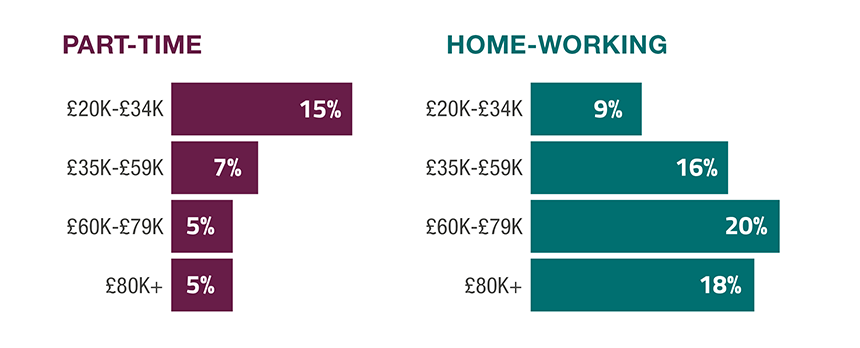
The higher the salary, the lower the availability of part-time jobs. Conversely, home-working (including hybrid working) is least available in lower paid jobs and peaks for jobs paid £60k-£79k.
These imbalances create unfairness in the workplace. The lack of part-time jobs at higher salaries traps many people in their low-paid part-time roles. It also creates barriers for those who take a temporary break from work and need a part-time role to re-enter the workforce. Meanwhile, hybrid arrangements, which make up the majority of home-working jobs, are primarily associated with higher-paid office roles and are inaccessible to many.
Greater parity can be achieved, if employers look more closely at what flexibility is possible in a role and design it into jobs.
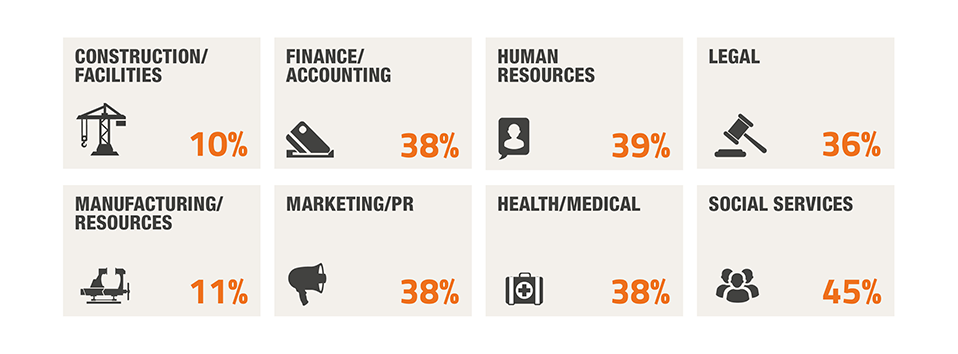
Access to flexible working at the point of hire varies widely depending on the type of role. Those that are largely based around shifts offer flex the most – for example social services (45% of job adverts) and medical/health (38%). Above average access to flex is also offered in a number of office-based role categories, because of increased home-working – for example, HR (39%), marketing (38%), and finance (38%).
But some role categories have stubbornly low rates of flex, such as manufacturing (11%), and construction (10%). This may be gender based – they are male dominated roles where historically low requests for flexibility may have shaped cultural resistance to it.
CIPD research published in May 2023 found that 49% of employers were not even aware of the 2023 legislation on flexible working, and the regulation around the day-one right to request it. So first, employers need to read up on the new legislation and think through how they will incorporate it into their processes.
The best way to gain knowledge and confidence on how to make flexibility work in your organisation is to find successful examples in your sector. Guidance on flexible job design will be helpful, as will advice on how to support line managers to implement flex.
Look particularly at how to make a success of hybrid working, which is currently the subject of much doubt amongst employers. Before you row back on hybrid, or decide not to trial it, invest time in understanding models that are successful.
And finally, it’s a mistake to assume that candidates will know they can ask for flexible working at interview. People who need flex want to know it’s on offer before they waste time on an application. This is especially true if they have been out of the labour market for a while, as they may lack the confidence to ask. So be sure to state clearly in your job adverts which types of flexibility are possible for the role.
Watch the Timewise Flexible Jobs Index© 2023 webinar below: